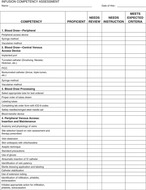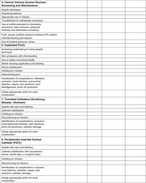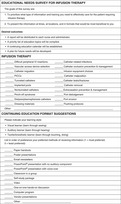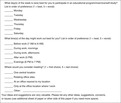CHAPTER 6. Clinician and Patient Education
Lynn Czaplewski, MS, ACNS-BC, CRNI®, AOCNS®∗
CLINICIAN EDUCATION
INTRODUCTION
Currently and historically, many schools of nursing do not include infusion therapy in basic nursing curriculums. Curriculums filled to capacity, faculty shortage, and lack of faculty knowledge in infusion therapy often prohibit its inclusion in the program (Smith, 2006). Infusion therapy skills or tasks may be taught in a skills’ laboratory but the theoretical knowledge necessary for safe practice may not be included. Theory, including peripheral and central catheter site selection, infusate properties, and infusion-related infection prevention and complications, is often not addressed or is imbedded in basic nursing information. A graduate nurse can leave school with little or no skill in infusion therapy or knowledge of the theory applicable to infusion practice. Some health care facilities offer a review of infusion therapy during orientation while others expect that the nurse is already equipped with those skills and knowledge. This results in fear and anxiety for the nurse, and patient dissatisfaction as a result of lack of nurses’ competency. In addition, litigation may result from a nurse’s lack of knowledge and poor skills. Integration of infusion therapy principles and standards into nursing curriculums is essential in a time when the majority of hospitalized patients receive some type of infusion therapy, and when infusion therapy is delivered in outpatient facilities, infusion clinics, and physicians’ offices, and in the home, schools, and workplace. It is likely that practicing nurses in most clinical settings require knowledge of infusion therapy. The Infusion Nursing Standards of Practice (Infusion Nurses Society [INS], 2006) recommend a curriculum for intravenous (IV) education to ensure the competency of nurses practicing infusion therapy (Box 6-1). These recommendations are intended for all nurses who care for patients requiring infusion therapy.
Box 6-1
INFUSION NURSES SOCIETY RECOMMENDATIONS FOR AN INFUSION CURRICULUM
1. Technology and clinical applications
a. Use, function, care, maintenance of supplies and equipment (Examples: catheters, administration sets, infusion control devices, needleless valves, dressings)
b. Potential risks and complications of supplies and equipment
c. Anatomy and physiology of vascular system
2. Fluid and electrolyte balance
a. Pathophysiology
b. Laboratory values
c. Types of fluids and electrolyte imbalances
d. Recognition of fluid overload, dehydration, abnormal acid-base balance
3. Pharmacology
a. Classifications of parenteral drugs including actions, pharmacokinetics, chemical properties, dosing, monitoring, side effects, toxicities, compatibilities, and stabilities
4. Infection control
a. Microbiology
b. Mode of transmission
c. Laboratory values
d. Surveillance
e. Prevention
f. Aseptic technique
5. Neonate and pediatric patients
a. Growth and development
b. Fluids and electrolytes
c. Dose calculations
d. Infusion delivery systems
e. Site and device selection
f. Psychological implications
6. Transfusion therapy
a. Immunohematology
b. Blood typing
c. Blood products
d. Equipment
e. Reactions
7. Antineoplastic and biologic therapy
a. Cell cycle
b. Goal of therapy
c. Laboratory values
d. Chemotherapeutic and biotherapeutic agents
e. Side effects and toxicities
f. Dosing
g. Administration and safe handling
8. Parenteral nutrition
a. Indications
b. Available solutions and additives
c. Metabolic processes
d. Monitoring
e. Potential complications
f. Monitoring
9. Performance improvement
a. Legal and ethical aspects
b. Outcome measurement
c. Standards of practice
d. Principles of continuous performance improvement
From Infusion Nurses Society: Infusion nursing standards of practice, J Infus Nurs 29(1 suppl), 2006.
Infusion nurses who have earned the CRNI® (Certified Registered Nurse Infusion) designation by successfully completing the CRNI® certification examination have become consultants and educators in all practice settings. The CRNI® may have the responsibility for staff development related to infusion therapy and competency assessment.
INFUSION-RELATED COMPETENCIES
Staff development is the process of assessing nursing competency and developing competencies, quality, and excellence in patient care (Kelly-Thomas, 1998). During orientation it is imperative to assess the competencies of the nurse. Typically nurses learn aspects of infusion therapy “on-the-job,” picking up information and skills that may or may not be accurate. “We’ve always done it this way” is a frequent mantra among nurses; misinformation and substandard care can result. Many nurses are unfamiliar with the Infusion Nursing Standards of Practice (INS, 2006), the Centers for Disease Control and Prevention (CDC) Guidelines for the Prevention of Intravascular Catheter-Related Infections (O’Grady et al, 2002), or even the Occupatioal Safety and Health Administration (OSHA) regulations. Nursing practice can become “tradition” in that the information is passed from nurse to nurse. It becomes the responsibility of the education department or staff development educator to correct misconceptions and teach evidence-based practice. It may be difficult to change those who are “set in their ways.” Evidence-based practice may be more readily accepted when nurses recognize and identify actual infusion-related complications and the cost to the patient in terms of pain, loss of income, and dissatisfaction if appropriate care is not provided.
Competencies are defined as the knowledge and skills required to safely practice an aspect or aspects of nursing. Competency assessment is an evaluation measuring a set of skills and knowledge required to provide care. It takes into consideration technical skills and critical thinking, and the ability to apply these competencies at the right time (Kelly-Thomas, 1998). Minimum nursing competency is demonstrated by a novice nurse who passed the National Council Licensure Examination (NCLEX®). Certification in infusion therapy by the Infusion Nurses Certification Corporation (INCC) validates through examination entry-level competencies in infusion therapy. Standards of practice, professional guidelines, and facility policies and procedures are the framework from which competencies are developed. Competency assessment is not a one-time-only process. It requires ongoing appraisal of skills and knowledge associated with high-risk procedures. Continuing evaluation of competency in health care organizations is necessary to meet the standards of accrediting bodies, such as The Joint Commission, and to ensure safe patient care. Methods of collecting evidence of staff competency may include performance evaluations, performance checklists, and written examinations. A list of examples of infusion-related competencies can be found in Figure 6-1.
 |
 |
| FIGURE 6-1 Infusion-related competencies. |
ADULT LEARNING
Whether teaching nursing staff or adult patients, consideration must be given to research-based learning theories to be effective. Cognitive learning pertains to perception, judgment, memory, and reasoning. Cognitive learning theories are based on Gestalt (German meaning to shape and form) psychology (Merriam-Webster, 2008). Gestalt laws are organizing principles that are part of perception. One law, the law of Pragnanz, states that we are innately driven to experience things as regular, orderly, and simply as possible. The law of closure says that a person will complete a thought, picture, or figure if something is missing, in other words “close the gap.” The tendency of a person to group similar items together forms the basis of the law of similarity. Insight learning is a well-known concept of Gestalt theory, which means solving a problem by means of recognizing an organizing principle. In essence, when a learner recognizes meaning in the experience, learning occurs (Merriam, Caffarella, and Baumgartner, 2006). This theory can be readily adapted to the process of infusion therapy competency development. A teaching plan that is organized and logical facilitates learning. For example, when preparing to teach peripheral IV insertion, including basic, preparatory information at the beginning of the lesson, such as recognizing types of peripheral IV catheters and selecting an appropriate gauge and length of catheter, is logical. This allows the learner to start to build upon basic concepts to the more difficult aspect of the lesson, which would be the venipuncture. Organizing information so that it follows the progression of steps to the venipuncture, dressing, and securement assists the learner in remembering the steps to be successful in that procedure. If the lesson skips important steps, such as allowing the antiseptic to dry, the learner may “close the gap” by assuming the venipuncture can be made through wet antiseptic. Presenting complications of peripheral venipuncture as part of the peripheral venipuncture lesson helps the learner to understand the meaning and implications of each step of the procedure.
Bruner (1966) identified three processes, occurring at the same time, that result in learning. The first process is acquiring new information; the second is taking the new knowledge and synthesizing it to see if it applies to a new task. During the third and last process—evaluation—the learner assesses whether the way the information was manipulated is adequate to the task. Learning through discovery is also emphasized. This approach is valuable because it helps the learner associate new information with something that is familiar. For example, a patient must learn how to use an ambulatory pump for home infusion. The patient has a microwave with a touch keypad. Using the knowledge about how to program the microwave may assist the patient in adapting that knowledge to the working of the pump. Programming the total time for the infusion, pressing a “start” key, and identifying alarms can be used as an example of knowledge familiar to the patient so that information can be applied to learning about the pump. Learning about the pump involves the acquisition of new information—why it is used, how it works, how to start and stop the pump, and how to identify troubleshooting alarms. New information can be “cubby-holed” into previous knowledge; therefore the information is more organized, easier to understand, and applicable to the use of a pump.
Three subconcepts to increase learning competence are recognizing the needs of the learner, taking into account the learner’s style of learning, and involving the learner in an organized activity (Smith, 1982). These concepts also align with the theories of the father of adult education, Malcolm Knowles. Learning is more likely to occur if there is some immediacy in the need to learn, that is, if the information can be immediately applied (Merriam et al, 2006). A nurse needs to learn how to change a peripherally inserted central catheter (PICC) dressing and cleanse the site. The nurse has a patient that needs a PICC dressing change. There is immediacy in the nurse’s need to learn this procedure. The nurse is more likely to assimilate that procedure because it will be applied immediately. If any problems occur during the dressing change, such as assessment of erythema at the insertion site, the nurse will be able to identify this complication and will learn to manage it based on the new information presented with the lesson on PICC site care. Smith (1982) also identifies that learning is very individualized, since each person learns best through different means. Some people learn new material most effectively visually, such as by watching a video or learning via the Internet. Others prefer to listen, using the sense of hearing, to learn. Listening to CDs while driving in a car is an illustration of that concept. “Learning while doing” or a hands-on approach is best for others. A combination of techniques for teaching and learning often strengthens the learning process and contributes to recall of the lesson. The learner may be shown a DVD regarding choices for venous access to illustrate the types of devices and how they are used. The nurse can reinforce that learning by discussing with the patient pros and cons of each device based on the patient’s lifestyle. By handling demonstration models of devices and manipulating a mannequin that has the devices, the patient is most likely to choose an appropriate device. In essence, the cognitive approach to learning is valuable because it helps the learner associate new information with something that is familiar.
The adult learning theory of Malcolm Knowles focuses on involving adult learners in the learning process. The theory is based on the following five assumptions about the adult learner:
1. Adults are autonomous and self-directed. They must be actively involved in the learning process and their perspectives about their learning needs must be sought.
2. Adults have a variety of life experiences and knowledge, prior education, work-related activities, and family responsibilities. Identifying what the learner already knows and building and relating educational experiences on prior knowledge engage the learner.
3. Adults are more problem-centered in learning and goal-oriented. If the learning can be immediately applied, it is more likely to occur.
4. Adults expect an organized program with defined objectives. Learners must clearly understand how the learning will help them achieve their goals.
5. Adults are relevancy-oriented and practical. Educational programs must be applicable to their work; they must see the value and be interested (Lieb, 1991).
In addition, adults need to feel respected. “Talking down” to an adult learner and not recognizing the learner’s current knowledge and expertise hamper learning. The following is an example of application of Knowles’ theory: Nurses in orientation in an outpatient oncology clinic need to learn how to assess and manage catheter occlusions. Central venous access device occlusions occur frequently in the oncology setting. As self-directed adults, the nurses can choose to learn the information or, if previously exposed to the information, can “tune out.” Whether or not the procedure is learned is up to the learner. Comparing catheter occlusion to clogged plumbing can be easily related to a commonplace household problem. Knowing that the assessment and skill of relieving occlusions will be used frequently in daily practice motivates the nurse to carefully learn the techniques.
ASSESSMENT OF LEARNING NEEDS
The first step in a successful program is determining the need for a program. Performing an educational needs assessment identifies what the learners believe is important information needed to safely and competently perform their job. It also helps the educator prioritize the requirements and interests of the learners. A needs assessment can be accomplished through a variety of methods. Methods may include using a questionnaire or survey, reviewing incident reports, observing nurses’ performance, or collecting data from exit interviews or from quality improvement activities. This might include results of chart audits, individual nurse feedback, nursing satisfaction surveys, written test results, new product evaluation, or implementation of new or revised policies and procedures, or feedback from orientation. An example of a nursing needs assessment survey can be found in Figure 6-2.
 |
 |
| FIGURE 6-2 Educational needs survey. |
TEACHING STRATEGIES
Once learning needs have been established and prioritized, methods for teaching and learning are determined. Selecting an appropriate format to use should be based on a number of factors such as urgency, availability of time, number of learners, and type of information to be learned. Urgency is a highly motivating factor creating a readiness to learn. If a patient is to have an implanted pump placed for pain management and the staff has never seen or worked with this device, the need to learn is urgent. Under these circumstances, education of staff involved in the care of the patient may need to occur within hours of caring for the patient. Time availability also impacts strategies for learning. If nurses can only attend educational programs when “off-duty” because of short staffing during work hours, creative methods need to be implemented. Motivating the learners to attend after-hours programs may be difficult. Personal and family responsibilities may deter the nurse from attending.
The number of learners also affects how learning is to occur. While a “just-in-time” inservice may be easily facilitated for a small group of nurses, a facility-wide program requires intense planning and creative interventions. The type of information that is to be learned affects program planning as well. The standard framework used for developing programs has long been Bloom’s Taxonomy of Educational Objectives. This framework identifies levels of learning within the cognitive, psychomotor, and affective domains (Harton, 2007). In each domain learning occurs by building on previous knowledge from the simple to the complex. The Revised Bloom’s Taxonomy (Anderson et al, 2001) identifies four types of knowledge: factual, conceptual, procedural, and meta-cognitive. Factual knowledge is basic, “must know” information such as knowing the types of central venous access devices and distinguishing characteristics. Conceptual knowledge is more complex, involving relationships and theories. Learning why a subclavian catheter tip position is not considered central placement based on the anatomy of the veins and the physiology of blood flow uses conceptual knowledge. When skills must be learned, procedural knowledge is used. Changing a PICC dressing using aseptic technique is using procedural knowledge, that is, task-oriented learning. Meta-cognitive knowledge involves the use of critical thinking to solve problems. The learner’s self-awareness and self-regulation come into play. When a nurse identifies a possible catheter-related sepsis and appropriately intervenes, meta-cognitive knowledge is applied. Box 6-2 lists examples of types of educational interventions. Not all types of programs are appropriate for all types of learning (Table 6-1).
Box 6-2
TEACHING STRATEGIES:EXAMPLES OF LEARNING ACTIVITIES
• Traditional lectures
• Discussions
• Self-learning modules
• CD-ROMs
• Games
• Simulations
• Train-the-trainer programs
• Computer-based programs
• Demonstrations
• Hands-on experiences
• Poster presentations
• Journal clubs
• Microsoft PowerPoint® presentations
• Case studies
| Type of information and examples | Strategies | Considerations |
|---|---|---|
Facts • New policy • Definitions • Anatomy/physiology • Fluids and electrolytes • Drugs | • Lecture • Self-study package • Webinar • Games • Handouts • Posters • CD-ROM | • Consider learner’s previous knowledge and build on it • Use pictures, drawings, algorithms • Include rationale |
Concepts • Advantages of one antiseptic over another • How catheter occlusions occur • Transfusion reactions | • Lecture • Slides • Self-study package • Webinar • Group discussion • Posters • Journal club • CD-ROM | • Involve learners • Use pictures, drawings, algorithms, concept maps • Use Infusion Nursing Standards of Practice • List resources/research |
Procedures • Insertion of a peripheral catheter • Site care • Handling a chemotherapy spill • Implanted port access | • Hands-on workshop • Demonstration • Practicum • Simulation • DVD/video • “Just-in-time” inservice • Posters | • Allow for practice time and return demonstrations • Use Policies and Procedures for Infusion Nursing • Identify best practice • Include rationale |
Meta-cognition • Troubleshooting a catheter occlusion • Evaluating lab values in a patient receiving parenteral nutrition • Choosing an appropriate vascular access device | • Case studies • Role playing • Simulation • Group discussion • Use of preceptors • Nursing rounds • Journal club | • Requires higher levels of thinking • Previous clinical experiences help to develop this domain |
PROGRAM PLANNING
The program curriculum can be planned after educational needs of the nursing staff are assessed, data are collected and analyzed, a list of priorities is developed, and the teaching topics are identified. In order for the right information to be taught in the right way, the target audience must be identified. Is the intended program meant for nurses new to the standards, policies, and procedures of the organization? Is it meant for nurses unfamiliar with the Infusion Nursing Standards of Practice and current research related to infusion nursing? Is the purpose of the program to teach experienced infusion nurses to perform an advanced procedure such as PICC insertion? Is the program for generalist nurses needing the basics of infusion therapy? Nurses working in a long-term care facility may rarely care for a patient requiring an IV antibiotic. Program goals of an IV program will differ greatly for that audience than for a group of interventional radiology nurses. Providing education for medical assistants or nursing assistants will not be at the same level as education for an experienced registered nurse (RN) nor will the goals be the same. A “one-size-fits-all” type of program cannot possibly meet the objectives for different types of learners. The program must be geared to the specific needs and objectives of the intended learners. An example of an intended audience statement is the following: “This program is intended for the graduate nurse with minimal or no experience in peripheral IV insertion.”
An essential part of every educational program is fun. Imbedding the program with appropriate cartoons, games, prizes, or treats helps keep the learner involved. A serious lecture program not only may be boring but also may allow the learner to mentally retreat from the task at hand.
To stimulate the learner, consideration of the generation of the learner is needed. Most programs will be comprised of learners from a variety of generations. The greatest number of nurses in today’s workforce were born from 1943 to 1960, the “Baby Boomers.” This generation values life-long learning and likes mentoring others. They enjoy taking a leadership role. “Generation X” consists of those born from 1961 to 1980. They comprise the second largest percent of the nursing workforce. Descriptions of this generation include intensely independent, self-directed, and resourceful. Work-life balance is important to them and they are very savvy with technology. Those nurses born from 1980 to 2000 are called “Millenials.” Social connections and networking are vital to them and they are interested in continuous learning. They value structure and need coaching (Sherman, 2008). To be successful in facilitating an educational program for a multigenerational audience, as an example, involve the Baby Boomers in the development of the program and in mentoring the younger staff. Schedule the program during the workday because Generation X’ers are not as likely to attend an off-hours program. Allow time for interaction and socialization to draw in the Millenials. Awareness of these generational differences will help to create a program that will be valued by all participants.
The next step is determining the objectives for the educational offering. A Taxonomy of Cognitive Objectives was developed by Benjamin Bloom in the 1950s and serves as a planning tool for learning objectives. In the 1990s, one of Bloom’s students, Lorin Anderson, revisited the taxonomy. The taxonomy provides a method of organizing thinking skills into six levels, from the most basic to the higher order of thinking (Table 6-2) (Anderson et al, 2001).
| Taxonomy | Sample verbs used in objectives | Examples of objectives |
|---|---|---|
1. Remembering—retrieving, identifying, and recalling relevant knowledge from long-term memory | Acquire Define Label Match Recognize List Describe Retrieve Name Locate Distinguish Repeat Know Choose Review Record Select Sort | • The nurse will be able to recognize the signs of a catheter-related sepsis. • The nurse will be able to distinguish a tunneled catheter from a nontunneled catheter. • The nurse will choose the correct blood collection tube when drawing a PT/INR. • The nurse will be able to define hypo- and hypertonic solutions. |
2. Understanding—comprehending meaning from oral, written, and graphic messages through interpreting, exemplifying, classifying, summarizing, inferring, comparing, and explaining; understand uses and implications of terms, facts, methods, procedures, concepts | Interpret Compare Demonstrate Differentiate Exemplify Infer Group Outline Predict Represent Trace Summarize Classify Explain | • The nurse will be able to interpret the signs and symptoms of hypoglycemia in the patient receiving PN. • The nurse will be able to classify the types of pain. • The nurse will be able to differentiate a febrile nonhemolytic reaction from anaphylaxis. |
3. Applying—executing or implementing a procedure; formulating interventions | Implement Convert Demonstrate Discuss Examine Prepare Carry out Use Execute | • The nurse will be able to demonstrate methods to distend peripheral veins. • The nurse will be able to implement a patient teaching plan for hand hygiene. |
4. Analyzing—breaking information into parts to explore understandings and relationships; evaluate relevancy | Compare Organize Find Classify Categorize Select Determine | • The nurse will be able to select a peripheral catheter insertion site based on the type of therapy and condition of the veins. • The nurse will be able to determine hypervolemia based on the patient’s signs and symptoms. |
5. Evaluating—justifying a decision or course of action | Check Interpret Verify Hypothesize Critique Experiment Judge | • The nurse will be able to verify a patient’s identification using two methods. • The nurse will be able to critique four infusion control devices based on selected criteria. < div class='tao-gold-member'>
Only gold members can continue reading. Log In or Register to continue
Stay updated, free articles. Join our Telegram channel
Full access? Get Clinical Tree


|